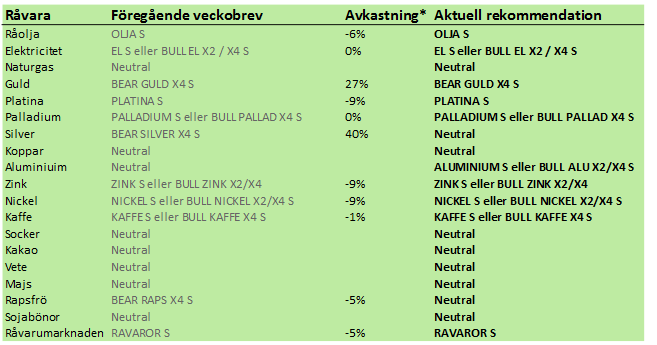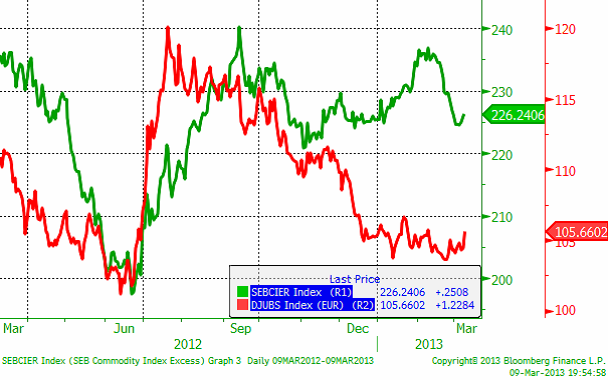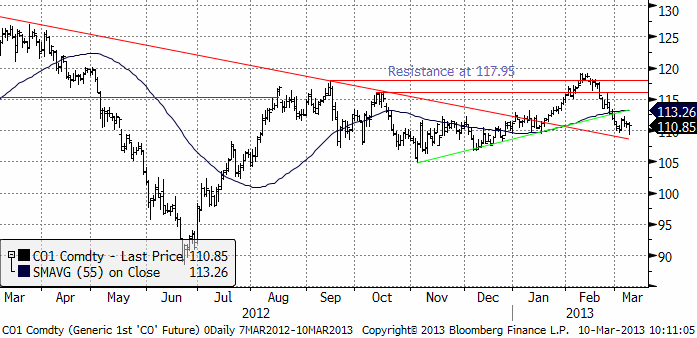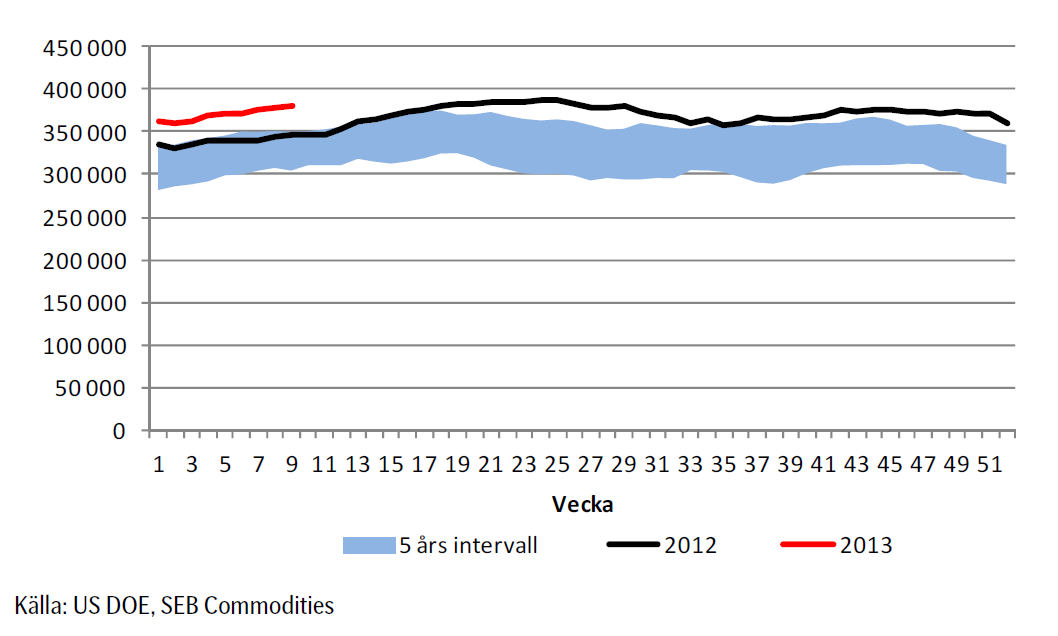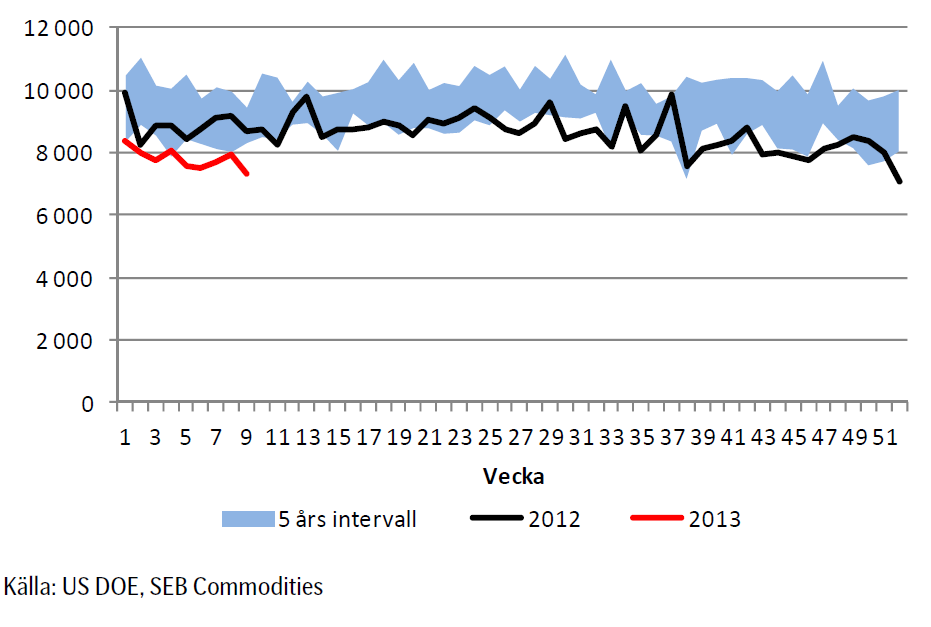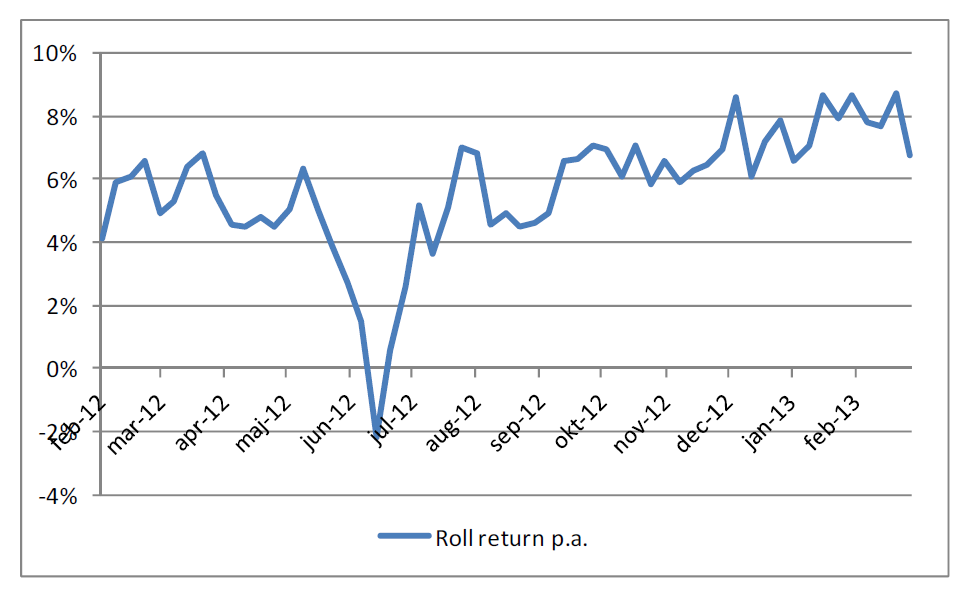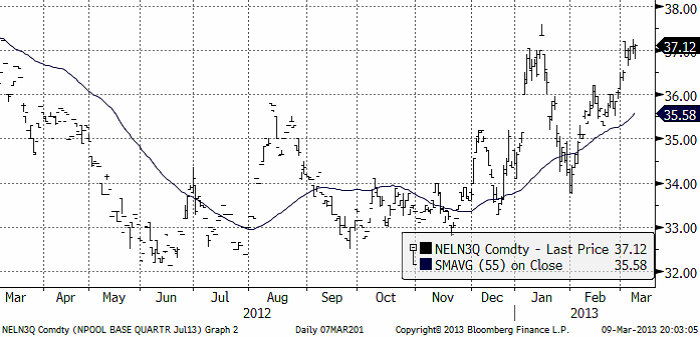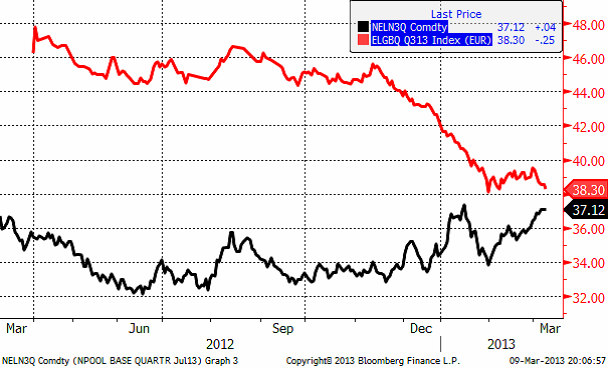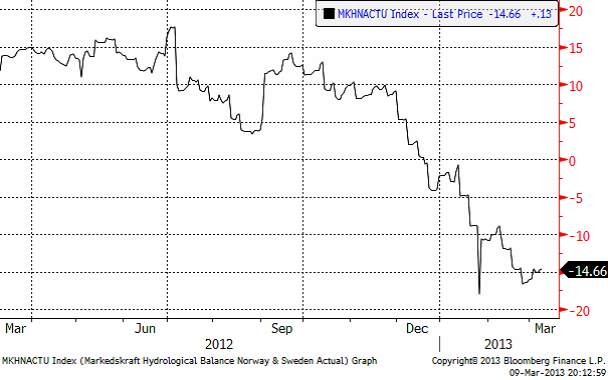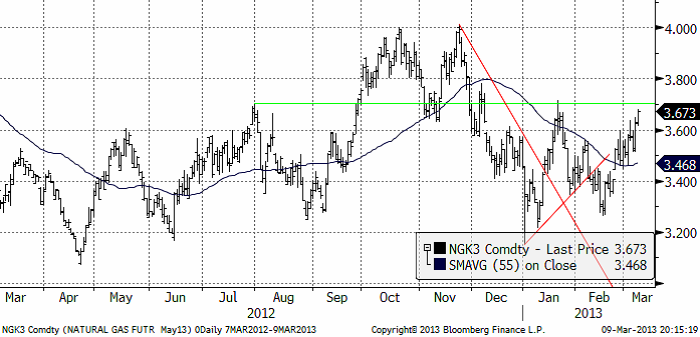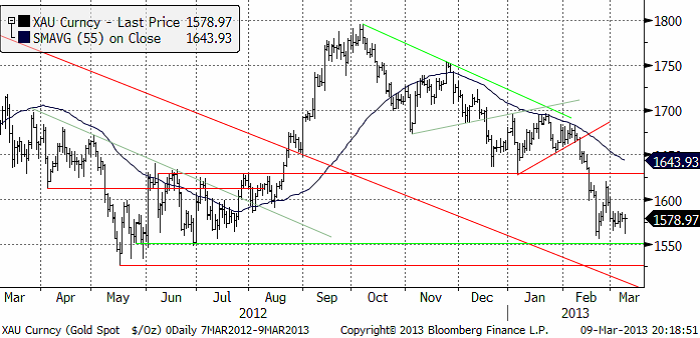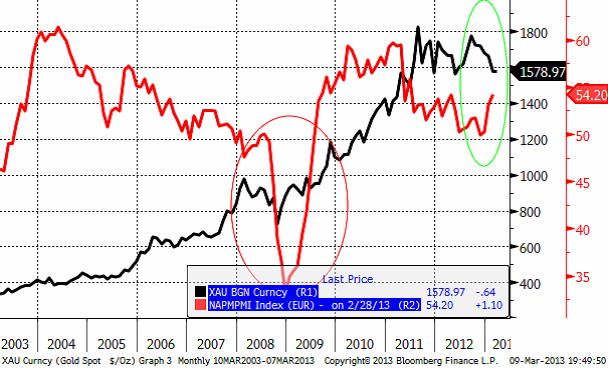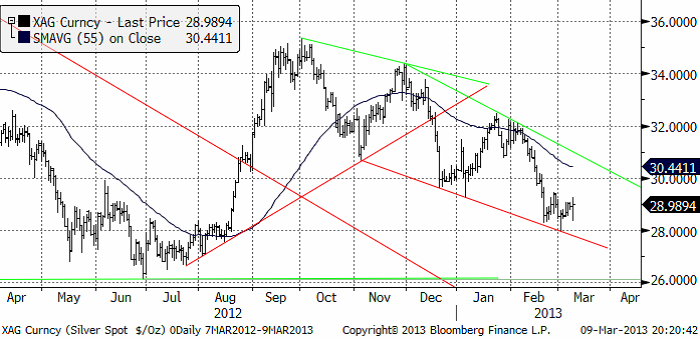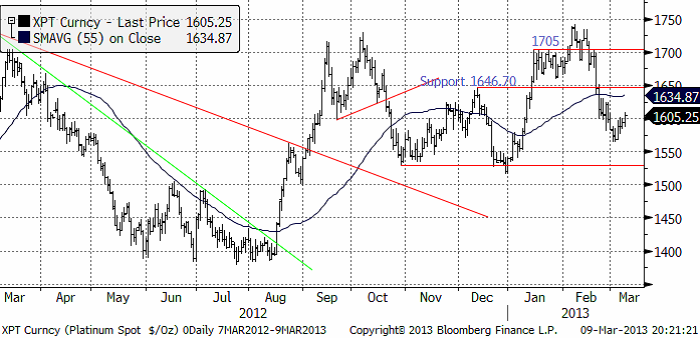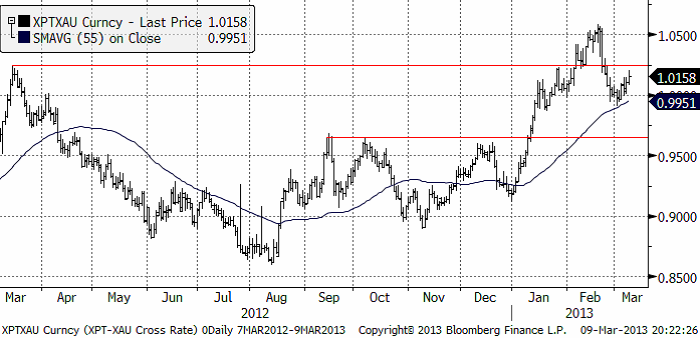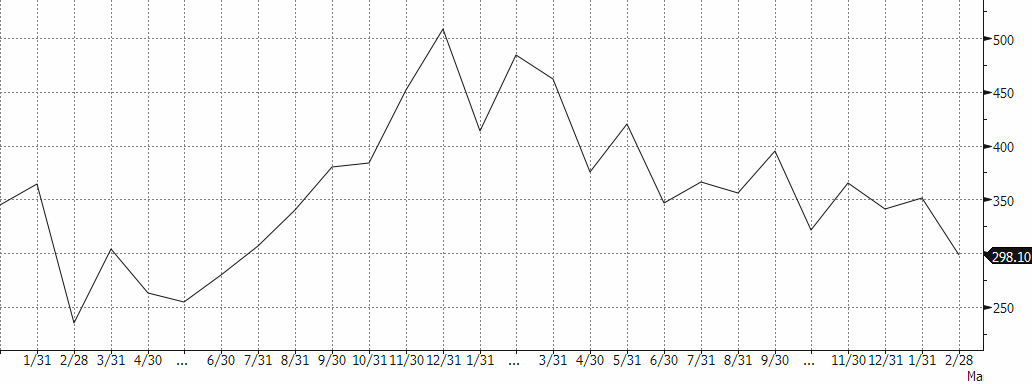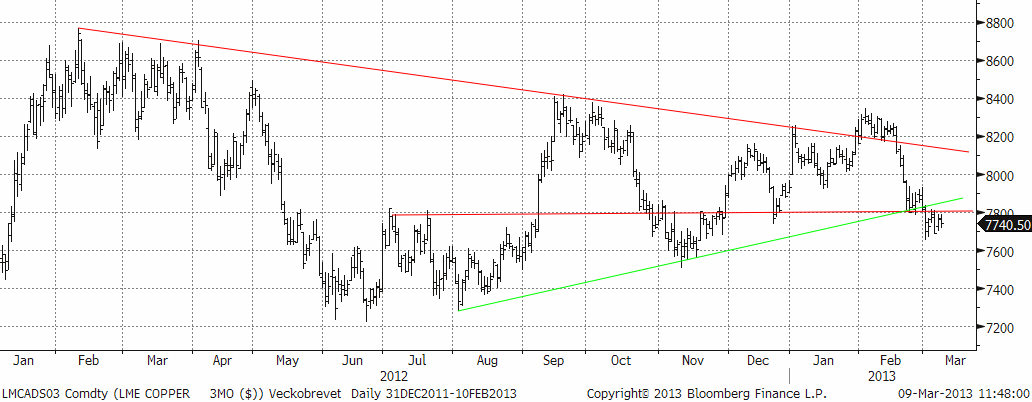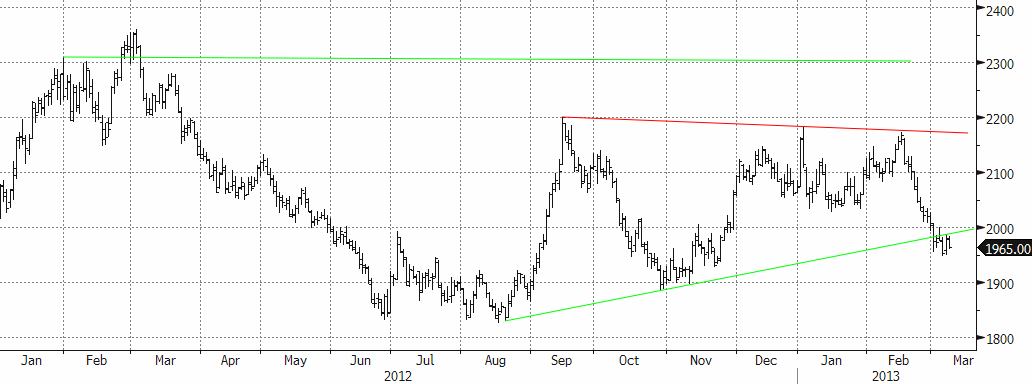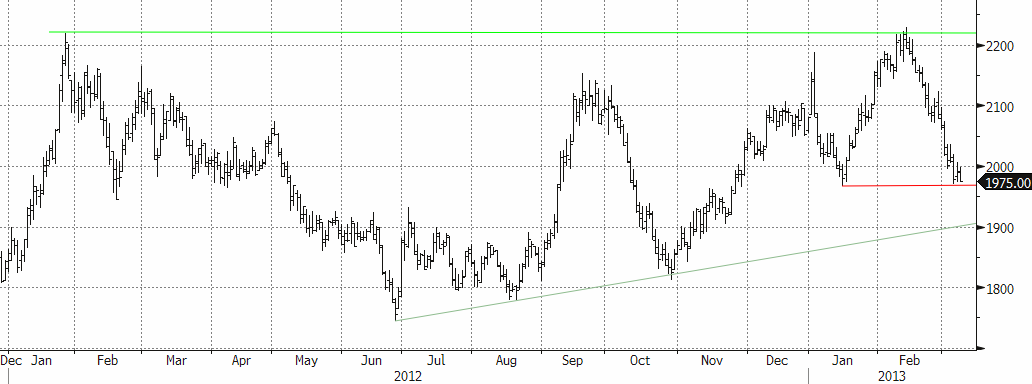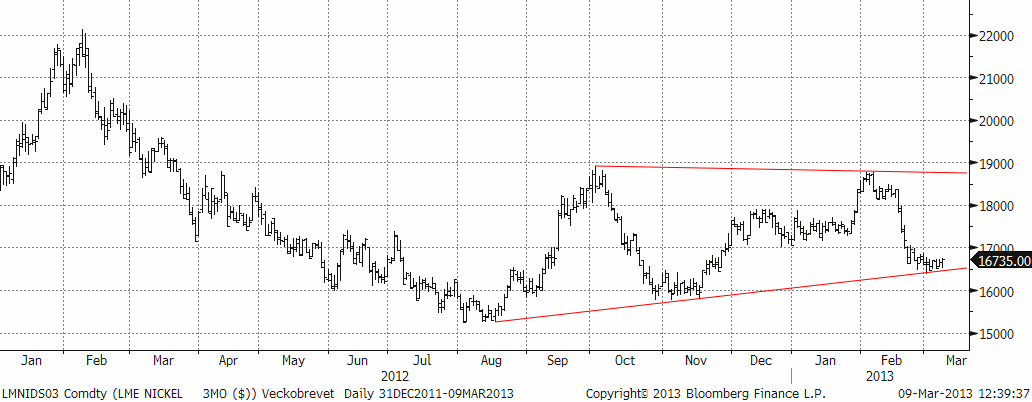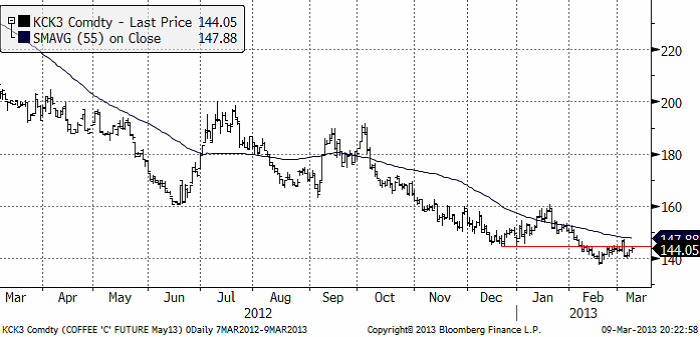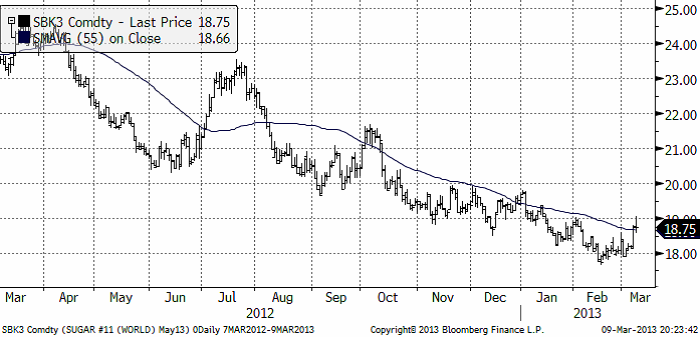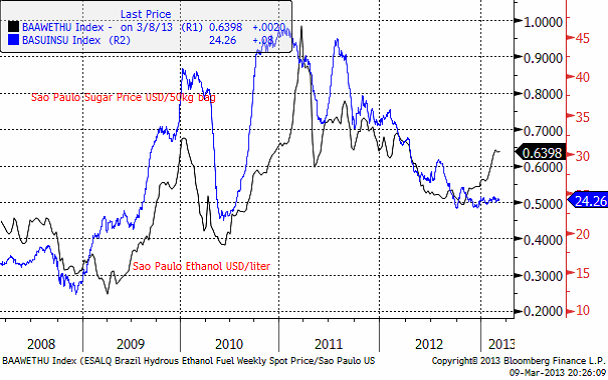Analys
SEB – Råvarukommentarer, 11 mars 2013

Rekommendationer
*) Avkastningen avser 1:1 råvarucertifikat där de ingår i rekommendationen. I den aktuella tabellen ovan har jag tagit prisförändringen den senaste månaden, eftersom den finns lätt tillgänglig och det är nästan en månad sedan det förra veckobrevet publicerades.
Inledning
Den korta positionen i guld och silver har gett fantatiskt hög avkastning den senaste månaden genom en rekommenderad position i BEAR GULD X4 S och BEAR SILVER X4 S. Vi tror att det finns en liten fallhöjd kvar i guld, men läget är sådant i silver att vi går ur och tar hem vinsten i BEAR SILVER X4 S.
Priset på palladium rusade i slutet av förra veckan. I fredags bröts ett motstånd. Den som är snabb kan säkerligen haka på och förmodligen göra en vinst. Detta är en mycket kortsiktig tradingrekommendation. Köp av BULL PALLAD X4 S, alltså.
Basmetallerna har fallit tillbaka med 9% den senaste veckan, vilket gör nickel och koppar – och nu även aluminium – tycker vi – ännu mer köpvärt ur ett fundamentalt perspektiv.
I fredags publicerade det amerikanska jordbruksdepartemetet sin månadsvisa uppdatering av utbuds- och efterfrågebalanserna i värdlen. Det var inga stora förändringar. Något negativt för vetet och något positivt för majs och sojabönor. Det har varit stora prisfall, som diskonterat ett väder som kanske kan bli bra. Vi tror att det stora prisfallet är bakom oss, men väljer att ligga kvar på neutral rekommendation ännu en vecka. Vi går däremot bort från rekommendationen att vara köpt BEAR RAPS X4 S.
Råvaruindex
I diagrammet nedan ser vi SEB:s råvaruindex, som följer avkastningen på en diversifierad korg av råvaruterminer. Sammansättningen är gjord med tanke på en nordisk eller europisk placerare. Indexet innehåller t ex terminer på nordisk och tysk el, men ingen amerikansk naturgas.
Indexet har slagit DJ UBS index med 8 procentenheter per år, vilket är statistiskt signifikant (p=0.11), förutom att vara tämligen ekonomiskt signifikant.
Den som vill investera i indexet och den investeringsstrategi som ligger bakom kan läsa mer om certifikatet RAVAROR S.
Indexet har gått ner med 4% den senaste månaden. Dollarn har minskat med 1%. Den samlade värdeförändringen på RAVAROR S är -5%.
Råolja – Brent
Oljepriset har fallit ner till 110 dollar per fat. Den tekniska bilden är otydlig med både brutet tekniskt stöd och att priset just nu vilar på ett annat tekniskt stöd.
Lagren och lagerförändringarna i USA per den 1 mars ser vi nedan, enligt Department of Energy och American Petroleum Institute.
Nedan ser vi amerikanska råoljelager enligt DOE i tusen fat. Den svarta kurvan är 2012 års lagernivåer vecka för vecka och den lilla röda linjen är 2013 års nivå. Vi ser att lagernivåerna fortsätter att vara högre än de varit sedan 2007 för den här tiden på året.
Lagren ökar samtidigt som vi ser att importen av råolja till USA fortsätter att minska.
Terminer handlas till en stabil rabatt i förhållande till spotpriset. Det innebär att det går att tjäna pengar på OLJA S, även om inte priset förändrar sig. Vi ser att denna riskpremie varit stabil det senaste året och uppgår till ca 7% på årsbasis. Jämfört med en kreditobligation som ger 7% ränta, har OLJA S fördelen att om ”något otäckt” händer i världen, t ex i Mellanöstern, leder det till att OLJA S ger högre avkastning, medan i princip allt annat som t ex aktier eller obligationer, faller i pris.
Sammanfattningsvis: Vi rekommenderar köp av OLJA S, men inte av BULL OLJA S. Anledningen till denna skillnad och att vi rekommenderar köp av OLJA S är för att rabatten på terminerna innebär en stadig intäkt om ca 6% till 7% per år + ränta på kapitalet.
Elektricitet
Underliggande för SEB:s certifikat på el är nu det tredje kvartalets terminskontrakt. Det avser alltså vad det genomsnittliga spotpriset kommer att bli under juli, augusti och september. Vi ser kursdiagrammet för det senaste året nedan.
Nedanför ser vi prisutvecklingen för det tredje kvartalets tyska elpriskontrakt (röd) och Nord Pools tredje kvartalskontrakt (svart). Det tyska priset har rört slutat falla för två månader sedan.
Den hydrologiska balansen för Nord Pools börsområde har faktiskt försvagats ytterligare, från -11.9 TWh till -14.7 TWh. Än mer intressant är att nuvarande väderprognoser är starkt högtycksinfluerade. Låga temperaturer och lite nederbörd beräknas snabbt urgröpa balansen ytterligare. Endast få veckor fram är den hela -21 TWh, ett signifikant underskott som vi anser inte helt prisats in i terminsmarknaden.
Sammanfattningsvis. En fortsatt god chans till högre elterminer men kolpriset är en osäkerhetsfaktor som kan hämma uppgången. Vi väljer att kvarstå vid vår long rekommendation.
Naturgas
Naturgasterminen på NYMEX (maj 2013) har handlats upp hittills i mars. Motstånd ligger precis ovanför dagens kursnivå. Vi har ingen speciell rekommendation just nu. Sidledes rörelse är mest troligt.
Guld och Silver
Guldpriset bröt först stödet vid 1670 dollar per ozt och sedan hände allt på en gång i fredags. Priset föll rakt genom stödet vid 1625, ända ner till 1600. Den nu aktuella prisnivån har en del stöd. Vi ser att det skedde en hel del handel på den här nivån i maj, juni och juli förra sommaren. Så det är möjligt att prisfallet hejdar sig mellan 1600 och 1550.
Vi tycker oss känna igen dagens svaga guldmarknad och starka konjunktursignaler från flera gånger förr, senast från bottenvändningen 2008/09.
Nedan ser vi kursdiagrammet för silver i dollar per troy ounce. Priset ligger nära botten i en trendkanal nedåt. Nivåmässigt borde det finnas stöd på den här nivån vid 28 cent. En rekyl uppåt kan komma. Den som vill ta en kortsiktig trade på den, kan göra det. Men läget är i vart fall inte entydigt negativt i det korta perspektivet, så vi väljer att gå ur vår köpta position i BEAR SILVER X2/X4 S.
Platina & Palladium
Palladiumpriset rusar och vi tror att priset kan fortsätta göra det. Den som vågar sig på en korsiktig momentum-trade kan köpa BULL PALLAD X4 S. Platinapriset rekylerade ner i februari. I mars har priset rekylerat uppåt. Sidledes rörelse verkar mest troligt.
Nedan ser vi priset på platina i termer av guld, eller ”växelkursen” mellan XPT och XAU, valutakoderna för de två ädelmetallerna. Platina har fortsatt att vinna på guld.
Palladium rusade i veckan som gick och stängde veckan över tidigare toppnotering. Ett sådant momentum brukar vara lönsamt att snabbt haka på, utan att tänka allt för mycket.
Basmetaller
Det har hänt en hel del – sedan det senaste veckobrevet skrevs (18 februari). Optimismen på förväntningar om ökad efterfrågan i Kina efter ledigheterna kring nyåret (det kinesiska), övergick till avtagande riskaptit och en våg av vinsthemtagningar som svepte över hela råvarufältet. Priserna har fallit tillbaka rejält. Basmetallerna är nu, om än marginellt, ner på året. Sedan topparna i februari har priserna fallit med mellan 5-10 %. Ett undantag är zink (se tidigare placeringsförslag) som håller sig bättre (oförändrad på året). Kina är väldigt avgörande för efterfrågan på basmetaller. Våra ekonomer är positiva till Kina, framför allt baserat på en fortsatt gynnsam kreditpolitik i landet. På 12 månaders sikt kvarstår bedömningen att priserna generellt har uppgångspotentialer i storleksordningen 20-30 %. De senaste veckornas vinsthemtagningar har skapat nya intressanta köptillfällen.
Koppar
Vi är dock fortsatt försiktigt inställda till kopparn. Vi följer Kinas importsiffror som en indikation på efterfrågan. Siffran i februari kom in på 298 tton (se diagram) jämfört med 350 tton i januari och 485 tton för ett år sedan. Februarisiffran bör dock tas med en nypa salt då ledigheterna i Kina påverkar rapporteringen. Icke desto mindre är trenden ganska tydlig.
Kinas kopparimport (1000-tals ton)
Den tekniska bilden ger stöd till vår neutrala position. Vi är positiva till basmetaller på sikt men avvaktar bättre köptillfällen alternativt väljer någon annan basmetall. Den stora triangelformationen börjar spela ut sin roll. Stödnivåer noteras vid 7600 och 7400. Nivån 7800 fungerar nu som motstånd.
Som vi skrivit tidigare tyder mycket på ökat utbud för koppar, vilket ökar risken för en lite trögare marknad. Vi ser inte den stora potentialen på koppar på uppsidan just nu. Vi rekommenderar därför en fortsatt neutral position. För den som vill satsa på ett starkare tillväxtscenario (än konsensus) i Kina är koppar däremot alltid ett intressant alternativ.
Aluminium
Som vi skrivit tidigare ligger aluminium väldigt ”fast” i ett relativt stort handelsintervall. Nivåer kring $1800-1900 utgör ur ett kostnadsperspektiv starkt stöd. Samtidigt lägger det stora utbudet ett ”tak” på nivåer kring $2300. Den senaste uppgången i februari mötte stora säljordrar från producenter som passade på att ”låsa” framtida priser, vilket satte press på marknaden. Nu när priserna fallit tillbaka ser vi stora intressen från köpsidan (fysiska förbrukare). För den ”trading-benägne” utgör det stora spannet goda vinstmöjligheter.
P.g.a. den låga prisnivån i relation till marginalkostnaden är aluminium köpvärd och vi ansluter den till köprekommendationerna.
Zink
Zinken har fått oförtjänt mycket stryk i den allmänna vinsthemtagningsvågen de senaste tre veckorna. Vi varnade för en rekyl, och den kom. Vi skrev senast att man bör vänta med nya köp till mellan $2000 och $2100. Priset har till och med fallit mer. Med tanke vår generella bedömning för basmetaller erbjuds nu ett nytt bra köptillfälle, och en andra chans att komma in i zinkmarknaden.
Priset ligger nu på stödnivån $1975. Tekniskt sett är alternativet att vänta (med risk för att missa uppgången) för att se om priset kan ta sig ner till stödnivån från trendlinjen kring $1900.
Vi rekommenderar köp av ZINK S eller BULL ZINK X2 / X4 S för den som vill ta mer risk. Vi varnade för rekylen, och nu när den skett är det köpläge igen. Priset ligger nu på stödnivån $1975.
Nickel
Efter den stora tillbakagången ser vi en tydlig stabilisering av priset. Ur ett kostnadsperspektiv börjar nickel bli en väldigt intressant köpkandidat. Marknaden är fortsatt tveksam till den fundamentala situationen. Vi har tidigare bl.a. hänvisat till kommentarer från fysiska aktörer som indikerar att ”det finns gott om nickel”, samtidigt som rapporter gör gällande att exporten av nickelmalm från Indonesien till Kina ökar igen, vilket riskerar att öka utbudet av s.k. Nickel Pig Iron i Kina (vilket i sin tur minskar efterfrågan på nickelbärande skrot och primärnickel). Det senare håller nu på att ”svänga om” då kinesiska producenter är snabba att ställa om produktionen. Det ger ett naturligt stöd till nickelmarknaden. Den tekniska bilden är väldigt tydlig med ett starkt stöd kring nuvarande nivåer. Nickel är tillsammans med zink (och från och med denna vecka även aluminium) en av de mer köpvärda metallerna för tillfället.
Vi rekommenderar köp av NICKEL S eller BULL NICKEL X2 / X4 S för den som vill ta mer risk. Vi varnade för en rekyl, och den kom. Priset har fallit mer än ”befarat”, men är nu på väldigt attraktiva nivåer.
Kaffe
Kaffepriset (maj 2013) gick i början av månaden upp till det glidande medelvärdet, vilket triggade säljordrar. Rekylen nedåt stannade dock på 140 cent och i slutet av förra veckan steg priset återigen upp mot motståndslinjen. Det ser ut som om priset håller på att etablera en botten och konsolidera sig med den vanliga ”sidledes” rörelse som vi brukar se under sådana skeenden.
Vi fortsätter att dela den uppfattningen och tycker att man ska handla kaffe från den ”långa” sidan. Vi fortsätter därför att generellt sett rekommendera köp av KAFFE S.
Socker
Sockerpriset (maj 2013) vände upp från kontraktslägsta i mitten av februari. I torsdags rusade priset och var uppe och rörde på 19 cent, som är ett tekniskt motstånd. Om priset skulle gå över 19 cent får vi en indikation på att prisfallet kan vara över. Fredagens prisfall efter att 19 cent uppnåtts kan dock tolkas som att marknaden behöver hämta kraft för ett nytt test av 19 cent.
Brasiliens regering vill öka användningen av etanol som drivmedel i landet. Många bilar i landet går att köra på både bensin och etanol, men priserna har varit sådana att folk har valt att tanka med bensin. Den ökade fokuseringen på etanol har fått priset att stiga, som vi ser i nedanstående diagram, som visar etanolpriset i Sao Paulo i USD per liter. Den blå linjen är priset på socker i samma delstat.
Vi ser att de två linjerna tenderar att hänga ihop och en uppgång i priset på etanol kan signalera att priset på socker också kommer att stiga framöver.
Finns tecken på att priset på socker är nära botten, men än så länge är pristrenden så stark att vi väljer att behålla neutral rekommendation ytterligare en vecka.
Vi tror att en trendvändning kan vara på gång. Prisuppgången till 19 cent, ett motstånd, är ett observandum.
[box]SEB Veckobrev Veckans råvarukommentar är producerat av SEB Merchant Banking och publiceras i samarbete och med tillstånd på Råvarumarknaden.se[/box]
Disclaimer
The information in this document has been compiled by SEB Merchant Banking, a division within Skandinaviska Enskilda Banken AB (publ) (“SEB”).
Opinions contained in this report represent the bank’s present opinion only and are subject to change without notice. All information contained in this report has been compiled in good faith from sources believed to be reliable. However, no representation or warranty, expressed or implied, is made with respect to the completeness or accuracy of its contents and the information is not to be relied upon as authoritative. Anyone considering taking actions based upon the content of this document is urged to base his or her investment decisions upon such investigations as he or she deems necessary. This document is being provided as information only, and no specific actions are being solicited as a result of it; to the extent permitted by law, no liability whatsoever is accepted for any direct or consequential loss arising from use of this document or its contents.
About SEB
SEB is a public company incorporated in Stockholm, Sweden, with limited liability. It is a participant at major Nordic and other European Regulated Markets and Multilateral Trading Facilities (as well as some non-European equivalent markets) for trading in financial instruments, such as markets operated by NASDAQ OMX, NYSE Euronext, London Stock Exchange, Deutsche Börse, Swiss Exchanges, Turquoise and Chi-X. SEB is authorized and regulated by Finansinspektionen in Sweden; it is authorized and subject to limited regulation by the Financial Services Authority for the conduct of designated investment business in the UK, and is subject to the provisions of relevant regulators in all other jurisdictions where SEB conducts operations. SEB Merchant Banking. All rights reserved.
Analys
Tightening fundamentals – bullish inventories from DOE

The latest weekly report from the US DOE showed a substantial drawdown across key petroleum categories, adding more upside potential to the fundamental picture.

Commercial crude inventories (excl. SPR) fell by 5.8 million barrels, bringing total inventories down to 415.1 million barrels. Now sitting 11% below the five-year seasonal norm and placed in the lowest 2015-2022 range (see picture below).
Product inventories also tightened further last week. Gasoline inventories declined by 2.1 million barrels, with reductions seen in both finished gasoline and blending components. Current gasoline levels are about 3% below the five-year average for this time of year.
Among products, the most notable move came in diesel, where inventories dropped by almost 4.1 million barrels, deepening the deficit to around 20% below seasonal norms – continuing to underscore the persistent supply tightness in diesel markets.
The only area of inventory growth was in propane/propylene, which posted a significant 5.1-million-barrel build and now stands 9% above the five-year average.
Total commercial petroleum inventories (crude plus refined products) declined by 4.2 million barrels on the week, reinforcing the overall tightening of US crude and products.


Analys
Bombs to ”ceasefire” in hours – Brent below $70

A classic case of “buy the rumor, sell the news” played out in oil markets, as Brent crude has dropped sharply – down nearly USD 10 per barrel since yesterday evening – following Iran’s retaliatory strike on a U.S. air base in Qatar. The immediate reaction was: “That was it?” The strike followed a carefully calibrated, non-escalatory playbook, avoiding direct threats to energy infrastructure or disruption of shipping through the Strait of Hormuz – thus calming worst-case fears.

After Monday morning’s sharp spike to USD 81.4 per barrel, triggered by the U.S. bombing of Iranian nuclear facilities, oil prices drifted sideways in anticipation of a potential Iranian response. That response came with advance warning and caused limited physical damage. Early this morning, both the U.S. President and Iranian state media announced a ceasefire, effectively placing a lid on the immediate conflict risk – at least for now.
As a result, Brent crude has now fallen by a total of USD 12 from Monday’s peak, currently trading around USD 69 per barrel.
Looking beyond geopolitics, the market will now shift its focus to the upcoming OPEC+ meeting in early July. Saudi Arabia’s decision to increase output earlier this year – despite falling prices – has drawn renewed attention considering recent developments. Some suggest this was a response to U.S. pressure to offset potential Iranian supply losses.
However, consensus is that the move was driven more by internal OPEC+ dynamics. After years of curbing production to support prices, Riyadh had grown frustrated with quota-busting by several members (notably Kazakhstan). With Saudi Arabia cutting up to 2 million barrels per day – roughly 2% of global supply – returns were diminishing, and the risk of losing market share was rising. The production increase is widely seen as an effort to reassert leadership and restore discipline within the group.
That said, the FT recently stated that, the Saudis remain wary of past missteps. In 2018, Riyadh ramped up output at Trump’s request ahead of Iran sanctions, only to see prices collapse when the U.S. granted broad waivers – triggering oversupply. Officials have reportedly made it clear they don’t intend to repeat that mistake.
The recent visit by President Trump to Saudi Arabia, which included agreements on AI, defense, and nuclear cooperation, suggests a broader strategic alignment. This has fueled speculation about a quiet “pump-for-politics” deal behind recent production moves.
Looking ahead, oil prices have now retraced the entire rally sparked by the June 13 Israel–Iran escalation. This retreat provides more political and policy space for both the U.S. and Saudi Arabia. Specifically, it makes it easier for Riyadh to scale back its three recent production hikes of 411,000 barrels each, potentially returning to more moderate increases of 137,000 barrels for August and September.
In short: with no major loss of Iranian supply to the market, OPEC+ – led by Saudi Arabia – no longer needs to compensate for a disruption that hasn’t materialized, especially not to please the U.S. at the cost of its own market strategy. As the Saudis themselves have signaled, they are unlikely to repeat previous mistakes.
Conclusion: With Brent now in the high USD 60s, buying oil looks fundamentally justified. The geopolitical premium has deflated, but tensions between Israel and Iran remain unresolved – and the risk of missteps and renewed escalation still lingers. In fact, even this morning, reports have emerged of renewed missile fire despite the declared “truce.” The path forward may be calmer – but it is far from stable.
Analys
A muted price reaction. Market looks relaxed, but it is still on edge waiting for what Iran will do

Brent crossed the 80-line this morning but quickly fell back assigning limited probability for Iran choosing to close the Strait of Hormuz. Brent traded in a range of USD 70.56 – 79.04/b last week as the market fluctuated between ”Iran wants a deal” and ”US is about to attack Iran”. At the end of the week though, Donald Trump managed to convince markets (and probably also Iran) that he would make a decision within two weeks. I.e. no imminent attack. Previously when when he has talked about ”making a decision within two weeks” he has often ended up doing nothing in the end. The oil market relaxed as a result and the week ended at USD 77.01/b which is just USD 6/b above the year to date average of USD 71/b.

Brent jumped to USD 81.4/b this morning, the highest since mid-January, but then quickly fell back to a current price of USD 78.2/b which is only up 1.5% versus the close on Friday. As such the market is pricing a fairly low probability that Iran will actually close the Strait of Hormuz. Probably because it will hurt Iranian oil exports as well as the global oil market.
It was however all smoke and mirrors. Deception. The US attacked Iran on Saturday. The attack involved 125 warplanes, submarines and surface warships and 14 bunker buster bombs were dropped on Iranian nuclear sites including Fordow, Natanz and Isfahan. In response the Iranian Parliament voted in support of closing the Strait of Hormuz where some 17 mb of crude and products is transported to the global market every day plus significant volumes of LNG. This is however merely an advise to the Supreme leader Ayatollah Ali Khamenei and the Supreme National Security Council which sits with the final and actual decision.
No supply of oil is lost yet. It is about the risk of Iran closing the Strait of Hormuz or not. So far not a single drop of oil supply has been lost to the global market. The price at the moment is all about the assessed risk of loss of supply. Will Iran choose to choke of the Strait of Hormuz or not? That is the big question. It would be painful for US consumers, for Donald Trump’s voter base, for the global economy but also for Iran and its population which relies on oil exports and income from selling oil out of that Strait as well. As such it is not a no-brainer choice for Iran to close the Strait for oil exports. And looking at the il price this morning it is clear that the oil market doesn’t assign a very high probability of it happening. It is however probably well within the capability of Iran to close the Strait off with rockets, mines, air-drones and possibly sea-drones. Just look at how Ukraine has been able to control and damage the Russian Black Sea fleet.
What to do about the highly enriched uranium which has gone missing? While the US and Israel can celebrate their destruction of Iranian nuclear facilities they are also scratching their heads over what to do with the lost Iranian nuclear material. Iran had 408 kg of highly enriched uranium (IAEA). Almost weapons grade. Enough for some 10 nuclear warheads. It seems to have been transported out of Fordow before the attack this weekend.
The market is still on edge. USD 80-something/b seems sensible while we wait. The oil market reaction to this weekend’s events is very muted so far. The market is still on edge awaiting what Iran will do. Because Iran will do something. But what and when? An oil price of 80-something seems like a sensible level until something do happen.
-

 Nyheter3 veckor sedan
Nyheter3 veckor sedanMahvie Minerals växlar spår – satsar fullt ut på guld
-

 Nyheter4 veckor sedan
Nyheter4 veckor sedanUppgången i oljepriset planade ut under helgen
-

 Nyheter4 veckor sedan
Nyheter4 veckor sedanLåga elpriser i sommar – men mellersta Sverige får en ökning
-

 Nyheter3 veckor sedan
Nyheter3 veckor sedanJonas Lindvall är tillbaka med ett nytt oljebolag, Perthro, som ska börsnoteras
-

 Analys3 veckor sedan
Analys3 veckor sedanA muted price reaction. Market looks relaxed, but it is still on edge waiting for what Iran will do
-

 Nyheter3 veckor sedan
Nyheter3 veckor sedanOljan, guldet och marknadens oroande tystnad
-

 Analys4 veckor sedan
Analys4 veckor sedanVery relaxed at USD 75/b. Risk barometer will likely fluctuate to higher levels with Brent into the 80ies or higher coming 2-3 weeks
-

 Nyheter3 veckor sedan
Nyheter3 veckor sedanDomstolen ger klartecken till Lappland Guldprospektering


